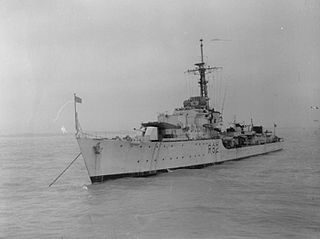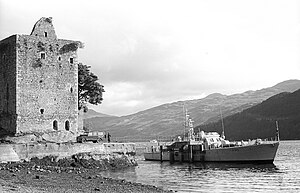
The Loch class was a class of anti-submarine (A/S) frigate built for the Royal Navy and her Allies during World War II. They were an innovative design based on the experience of three years of fighting in the Battle of the Atlantic and attendant technological advances. Some shipyards had trouble building these larger ships, which led to widespread use of the Castle-class corvette, introduced around the same time.

HMS Pelorus was an Algerine-class minesweeper built for the Royal Navy (RN) during World War II. Upon completion, the ship became the flotilla leader of the 7th Minesweeper Flotilla, clearing mines off the east coast of England. In June 1944, the flotilla was assigned to sweep one of the beaches during the Normandy landings until she struck a mine the following month. After her repairs were completed, Pelorus was reassigned to the English Channel and the 6th Minesweeping Flotilla. The flotilla was transferred to the Indian Ocean in 1945 and spent some time escorting convoys. They participated in Operation Collie, a bombardment of Japanese positions in the Nicobar Islands, in July and then swept the Strait of Malacca and the approaches to Singapore in August.

The Type 16 frigates were a class of British anti-submarine frigates of the Royal Navy. They were based on the hulls of World War II-era destroyers that had been rendered obsolete by rapid advances in technology. They were similar in concept to the Type 15 frigate, but were a far more limited design rendered necessary by budget constraints.
HMS Asheldham was one of 93 ships of the Ham class of inshore minesweepers.
HMS Bodenham was one of 93 ships of the Ham-class of inshore minesweepers. Completed in 1953 for use in the British Royal Navy, she served as a tender to HMS Vernon between 1954 and 1955 before being placed in reserve. In 1967 she was transferred to the newly-independent country of South Yemen renamed Al Saqr. She was renamed Jihla in 1975 and discarded in 1984.

HMS Cachalot (S06) was a Porpoise-class submarine. Her keel was laid down on 1 August 1955 by Scotts Shipbuilding and Engineering Company at Greenock. She was launched on 11 December 1957, and commissioned on 1 September 1959.

HMS Marne was an M-class destroyer of the Royal Navy commissioned on 2 December 1941. She was built by Vickers-Armstrongs at High Walker Yard, Newcastle-upon-Tyne, England, and saw service in the Atlantic theatre of World War II.

The QF 4 inch Mk XVI gun was the standard British Commonwealth naval anti-aircraft and dual-purpose gun of World War II.

HMS Ascension (K502) was a Colony-class frigate of the United Kingdom that served in the Royal Navy during World War II. She originally was ordered by the United States Navy as the Tacoma-class frigateUSS Hargood (PF-74) and was transferred to the Royal Navy prior to completion.

SAS Good Hope was one of three Loch-class frigates in the South African Navy (SAN). It was built as HMS Loch Boisdale (K432) for the Royal Navy during World War II, but was transferred to the SAN before completion in 1944 and renamed as HMSAS Good Hope. The ship was assigned to convoy escort duties in 1945, but did not encounter any enemy ships before the end of the war.

HMS Crispin was a C-class destroyer of the Royal Navy built by J. Samuel White, Cowes between 1944 and 1946. She was originally to have been named HMS Craccher. She was sold to the Pakistan Navy in 1958 and renamed PNS Jahangir. She was scrapped in 1982.

HMS Creole was a C-class destroyer of the Royal Navy built by J. Samuel White, Cowes between 1944 and 1946. She was sold to the Pakistan Navy in 1958 and renamed PNS Alamgir. She was scrapped in 1982.

HMSAS Natal was one of three Loch-class frigates in the South African Navy (SAN). It was built as HMS Loch Cree (K430) for the Royal Navy during World War II, but was transferred to the SAN before completion in 1945 and renamed as HMSAS Natal. Just hours after finishing fitting out, the ship sank a German submarine off the coast of Scotland in early 1945. It was assigned convoy escort duties for the remaining few months of the war in Europe. Natal had her anti-aircraft armament reinforced for service in the Far East after arriving in South Africa in June. In September–October, the ship participated in the reoccupation of British Malaya before returning home the following month.
HMSAS Bloemfontein was an Algerine-class minesweeper built for the Royal Navy in Canada during World War II. The ship was originally HMS Rosamund and spent several years clearing minefields in European waters after she was completed in 1945 before she was placed in reserve. Rosamund was purchased by South Africa in 1947 and renamed HMSAS Bloemfontein in 1948.
INS Brahmaputra (F31) was a Leopard-class frigate of the Indian Navy. She was built by the Scottish shipbuilder John Brown & Company and completed in March 1958. Brahmaputra served during the Indo-Pakistani War of 1965 and the Indo-Pakistani War of 1971. She was scrapped in 1986.

HMS Gifford was one of 23 boats of the Ford class of patrol boats built for the Royal Navy in the 1950s. Gifford was launched on 30 June 1954. In 1968 the vessel was sold to Nigeria and renamed NNS Bonny. Bonny took part in the Nigerian Civil War and was decommissioned in 1983. Bonny is preserved at the Nigerian War Museum in Umuahia.
HMS Montford was one of 23 boats of the Ford class of patrol boats built for the Royal Navy in the 1950s.
HMS Stubbington was a Ton-class minesweeper which saw service with the Royal Navy during the Cold War. Built by Camper & Nicholson, Portsmouth, she was launched on 8 August 1956. She served as a minesweeper in the Mediterranean and the Middle East in the 1950s and 1960s, and in the Royal Navy Reserve under the name HMS Montrose from 1972 to 1976. She then was used for Fishery Protection duties. Stubbington was broken up in 1989.

SAS Skilpad was a mine-layer vessel of the South African Navy during and after the Second World War. She was launched as the German trawler Polaris and after being captured by the Allies in 1940, she was commissioned into the Royal Navy as a war-prize and named HMS Spindrift. During the course of the war she was transferred to the South African Naval Forces, being based in Saldanha Bay and later in Durban. After being kept in storage for several years after the end of the war, she sank at her moorings in Durban during a gale in 1953, leading to her being decommissioned and sold for scrap in 1957.













